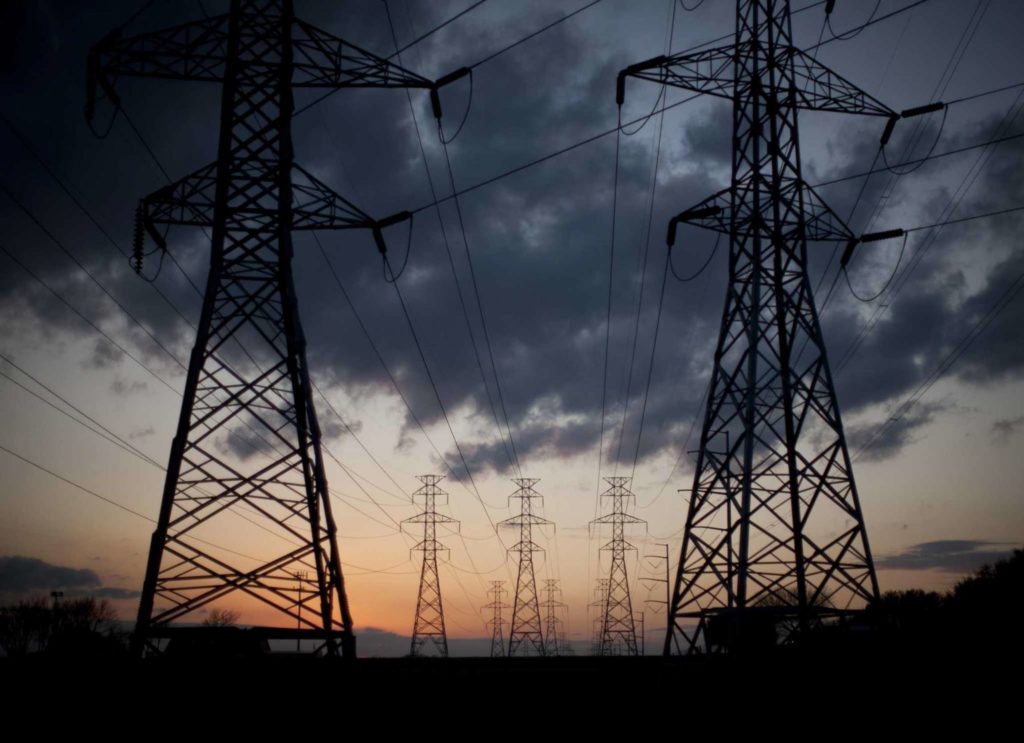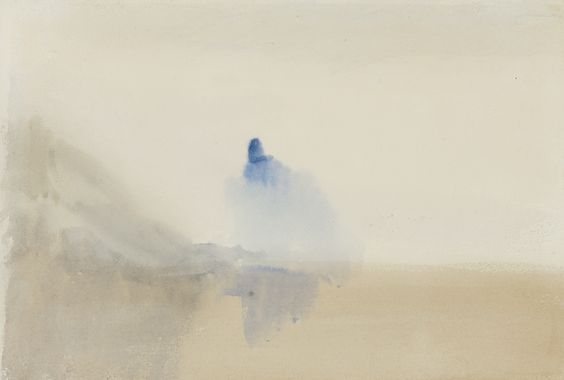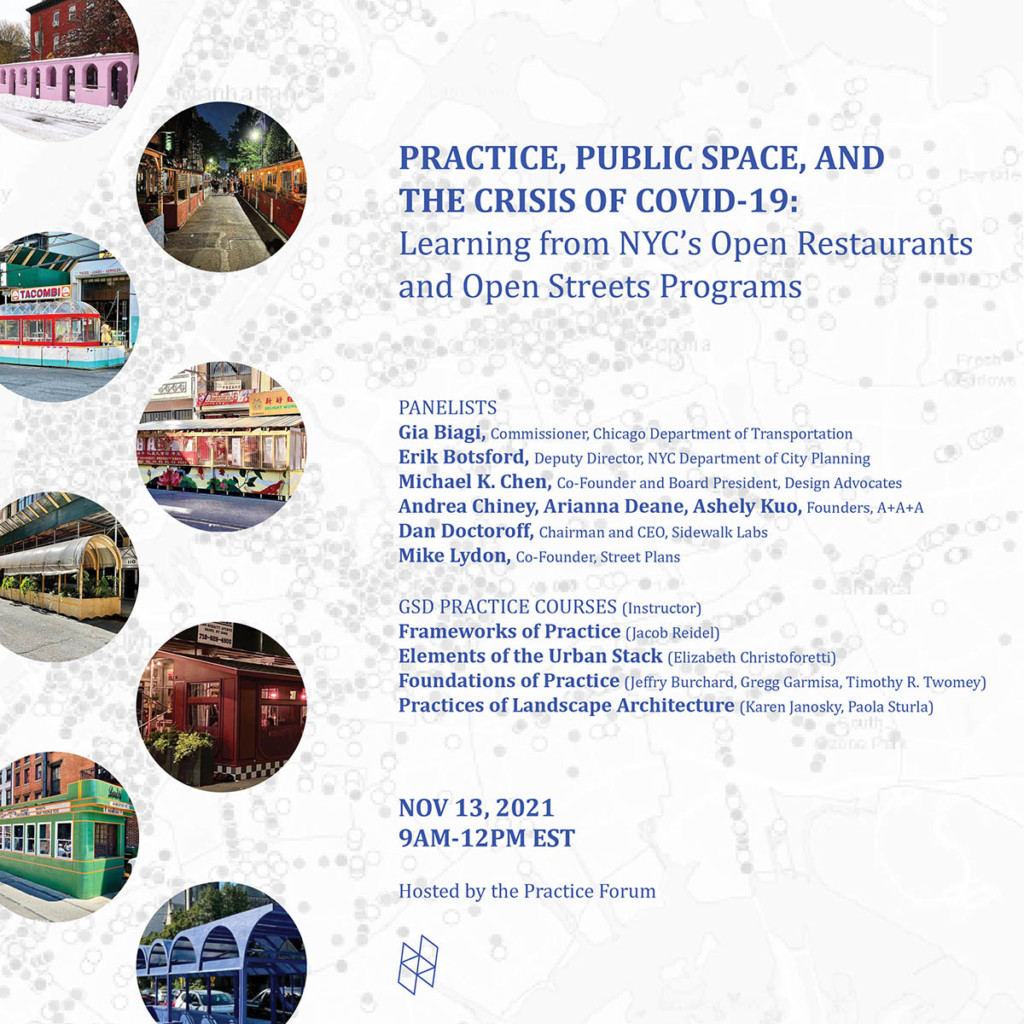At their speculative edge, the design professions flourish in envisioning future scenarios, and we usually imagine these to be positive additions to a well-ordered world. A true crisis throws fundamental assumptions into disarray, requiring designers to rethink the way they operate as the ground shifts beneath their feet. The old rules of geopolitics suddenly don’t lead the imagination anywhere predictable. What’s left is a feeling that the game itself is being reinvented.
In the past two years, the theme of crisis has been studied across the GSD at the annual Practice Plenary, and lessons learned by investigating responses to pandemics and hurricanes can help us look at responses to crises happening now across the globe. I spoke with three professors teaching practice courses and plotting new modes of practice in architecture and urban planning. All three encouraged humility, and they spoke of the central place for self-reflection in designing a profession better able to address injustices and inequalities. Asked about the ongoing war in Ukraine, Elizabeth Christoforetti, a founding principal at Supernormal and an assistant professor in practice of architecture, urged caution: “It’s a response time question. We’re just not built to respond quickly as a profession. It can feel frustrating, not being able to confront the crisis, but our impact happens in different ways.” Jacob Reidel, also an assistant professor in practice of architecture and a senior director at Saltmine, a technology startup, suggested that designers “focus on what our responsibility is as engaged citizens,” noting that “there’s a tendency to try to make everything a design problem—but there are other ways one can and should be active in the world.” Matthijs Bouw, founder of One Architecture and Urbanism, saw a parallel between his work on climate adaptation and the exodus from Ukraine (there are more than 5 million refugees so far): “One of the things I worry about is how our cultural fabric will be able to cope with the climate crisis and the associated migration. It’s going to change our cities in drastic ways.” The war also exposes problems with the global energy infrastructure: “We should have been investing much more in renewables and decentralized systems,” Bouw says. “This is an issue of environmental justice. Who gets to own the energy infrastructure? Many communities have really suffered in the past from energy infrastructures.”
Bouw’s work and teaching at the GSD has placed designers at the edge of several unfolding crises. Among his best-known projects at One Architecture and Urbanism is the Big U—a proposal for a protective system that encircles Manhattan to mitigate the effects of rising sea level—which was originally developed with a multidisciplinary team including BIG (Bjarke Ingels Group). The associated research and design continues in ONE’s work on the Financial District and Seaport Climate Resilience Master Plan, among other projects. This semester at the GSD, Bouw is teaching “Houston: Extreme Weather, Environmental Justice, and the Energy Transition.” The course begins with the premise that crises have a tendency to build on one another. Bouw says it’s important to distinguish between two types of crisis: “There are slow-running crises that are eating away at people’s health and livelihoods, or coastal areas, or ecosystems, and then there are catastrophic crises that are—in the language of resilience—low probability and high impact.”
As Bouw explains, “During COVID, we have seen how public health is related more than ever to issues of structural racism, to our fossil fuel economy (because of pollution and respiratory issues), and so on.” This logic applies to other crises as well: “The climate crisis is intimately connected to the biodiversity crisis.” The complexity inherent to interrelated systems is the first problem found in crisis situations, he says. “There is a lot that we don’t know about these relationships, but we do know that many of these relationships play out on a systemic scale and bring with them a high level of uncertainty.”
Bouw advises that we should approach crisis through careful research and as part of a team. “Projects you do as a practitioner cannot stand on their own,” he says. “Any project is part of something much bigger.” This can be an uncomfortable situation for designers: “I was trained as a designer to stand in front of an audience and say, ‘This is the big idea,’ and then try to sell the idea,” Bouw says. “That’s an ethic of the past. You need to start thinking about yourself more as a participant in a much more complex process.” Design in face of crisis requires “the right mix of willfulness and humility.”
This doesn’t mean abandoning the tried-and-true techniques of design. Bouw emphasizes the importance of “tools for communication—creating the material to make conversations easier—and the tools of research through design exploration.” He says that design professionals play an important role as mediators: “Balancing the systemic dimension with the hyperlocal or the hyperprecise is what we do.” This is particularly important in large-scale crises, which are also largely invisible. Take the climate crisis, for example. “Given the magnitude of changes that we need to make in our Earth system,” Bouw says, “we need to develop quick ways of learning and protocols that can be scaled and replicated, and which don’t get in the way of the nuance that’s needed in some situations.” He cautions that there is no single framework for understanding something so complex. “The Earth system as a whole cannot be captured in an algorithm,” he observes. “You need to understand the limits of the algorithms you develop because otherwise you start to reduce reality to the algorithms.”
Asked about specific participatory design practices, Bouw notes that they vary around the world: “In planning in the Netherlands, we are employing design in a more integrated way to engage complex processes. Planning in the United States is relatively disassociated from design—the tools of planning are predominately things like texts and spreadsheets and PowerPoints. It doesn’t tend to test things and try to see how things come together on the ground.” For Bouw, this tendency avoids the crucial questions of practical engagement: “What would it take to implement this? Where could it get funding from? How do we engage the powers that be in the set processes of delivering projects?” Without practical, on-the-ground participation, Bouw says, “the end is often either paralysis or business as usual, and we can’t do either.”
Crisis frequently spurs invention. In her class this semester, Elizabeth Christoforetti focuses a historical lens on a range of design practices to ask when and why they were first formulated. “Products of Practice” begins by showing students that “the profession of architecture is actually relatively new,” she says. “It came out of a number of radical social and economic changes—the French Revolution and the Industrial Revolution, for instance.” The course builds on Christoforetti’s class last semester, “Elements of the Urban Stack,” which delaminated the built environment from its most expansive social fabric to its smallest detail. Across both classes, Christoforetti asks students to “look back at historical hinge points to see, for instance, how architectural specifications changed over time and how those changes impact the architect’s agency or relationship with society.”
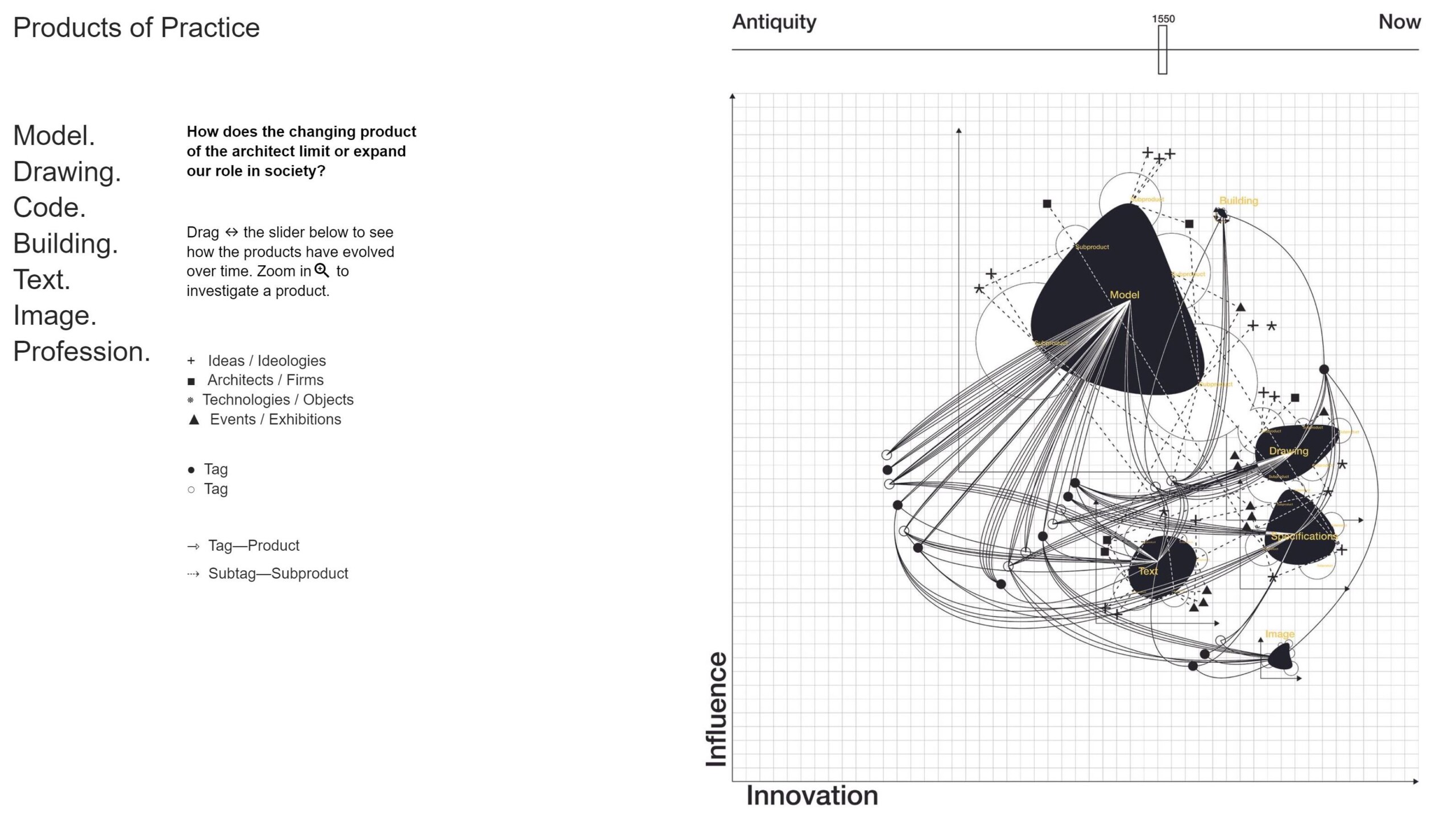
This approach gives students a perspective on the possibilities of design practice. “The best thing we can do is to understand the limits of the structural framework of practice now,” Christoforetti says, “and where we can or must push boundaries if we want to change things.” Critical reflection plays an important role in formulating new directions. “We can identify what the value systems out there are—in the discipline, in practice, and in society at large,” she says. “Then if architects want to impact the future of housing, for example, maybe the thing to do isn’t to design a single-family home. Maybe it would be better to go work for Fannie Mae and design mortgages, because they shape housing at scale. Or maybe it’s okay to just design a really remarkable single-family home. But it’s a choice about impact and agency.”
This wider view of practice suggests an expanded notion of professional ethics. Christoforetti asks, “Do we need a redefinition of design in an era when we are accountable to the major crises of the moment, whether it’s climate change, war, systemic racism, or computer surveillance? Is form enough?” This can appear sometimes as a drastic decision to be made—a fork in the road. “Maybe we’re thinking about how to fundamentally redefine our practice, and maybe the profession as we know it dies as a result,” Christoforetti speculates. This sort of wholesale redefinition has happened before, and like previous hinge points, she says, “We live today in an unprecedented moment for the role and agency of the designer.”
When it comes to dealing with the compounding crises of the contemporary world, Christoforetti is particularly interested in the problems and potentials of computation. She cites Architectural Intelligence by Molly Wright Steenson which mentions that, in the world of technology, the verb “to architect” refers to the design of information systems. “The people she writes about are not thinking about buildings per se,” Christoforetti says, “they’re thinking about something much bigger. They’re thinking about an operative process for creation.” She pinpoints the central conundrum of contemporary professional practice in a way that parallels Bouw’s observations: “The crisis that we look at in “Products of Practice” is one of scalable systems and late capitalism.”
The professional practice course taught by Jacob Reidel last semester also took a historical perspective. He notes that “the profession of architecture as we currently understand it is not nearly as old or straightforward as is often assumed.” On this basis of historical contingency, “Frameworks of Practice” is designed to get students “to look critically at what they’ve been told it means to be an architect, and to see both the profession and their own careers as designed things,” Reidel says. Opportunities provided by unexpected circumstances offer a good starting point for this investigation. “Crises, even if only temporarily, tend to throw the old way of doing things out the window,” says Reidel, and he has numerous examples.
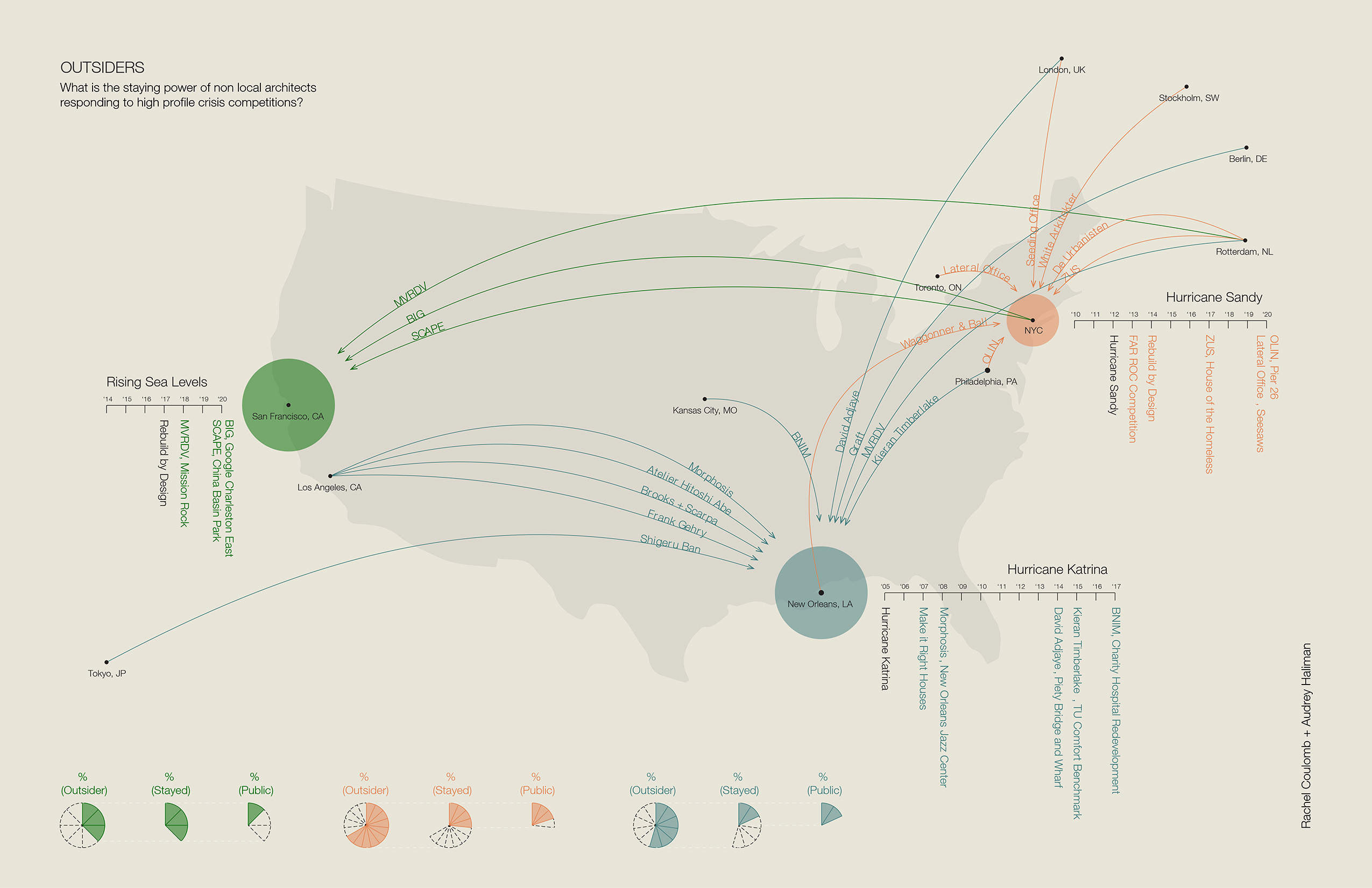
“One of the few built responses to the crisis of COVID,” he points out, was the “thousands of structures built in the street, practically overnight, in one of the most heavily regulated built environments in the world, New York City. All the rules had to be rewritten, and myriad public and private entities had to come together to figure out how to make it possible for the restaurant industry to continue operating. Suddenly the Department of Transportation was regulating building because the shacks were in the street.” The result was the Open Restaurants and Open Streets programs, the latter of which set itself the task of “transforming streets into public space open to all,” according to their website. This made for an apt case study in the relationship between crisis and design—and it became the subject of the second Practice Plenary.
Reidel brings the questions raised by Open Restaurants and Open Streets to bear on a wider investigation of design. “What did it reveal about how the design professions can and cannot effectively engage in moments of crisis?” he asks. One lesson involves seizing opportunity. Reidel tells the story of the creation of the re-ply program: “During the first COVID summer of 2020, many businesses in New York City temporarily covered their storefronts in plywood. Seeing that a ton of valuable plywood was headed to the dump, members of the small New York studio of the international Australian practice BVN began collecting plywood from businesses and landlords, some as big as Rockefeller Center’s Tishman Speyer, and started a pro bono effort to repurpose it into affordable outdoor seating for local restaurants that couldn’t serve food indoors because of COVID. What started as plywood furniture eventually became a kit-of-parts streetery building system named re-ply that’s now operating almost like a small independent product business within the larger BVN design practice.” It’s an example, Reidel says, of how a crisis can spur “new approaches to operating as an architect.” The example suggests the importance not only of having a good eye for opportunity, but also of being prepared. This is the practical, on-the-ground knowledge that Bouw also emphasized.
Although the place of design may be far from the battlefield, it can help to think about crisis situations in terms of wartime mobilization. “What we are trying to do as a practice is to have the boots on the ground and to change the practices of implementation,” Bouw says. “It is difficult to build coastal adaptation projects or integrated stormwater projects that also improve the urban environment as a whole and deal with other systemic issues. We have to create the conditions necessary to capitalize on those opportunities.” A lot of the work involved in addressing crises comes beforehand, in the form of research and planning—and this requires being out there, on the ground, embedded in the complex systems in which we may have to intervene. So whether it’s destabilized ecosystems, new technologies, or something else driving change, Bouw’s advice applies: “A shock is also often an opportunity, but we need to have equitable plans ready before the event occurs.”
